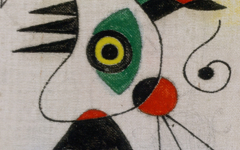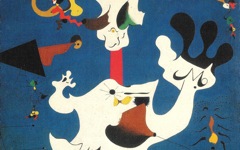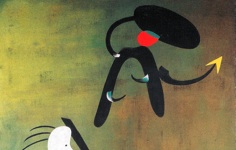Miró‘s Painting / The Circus Horse (1927)
This painting by Joan Miró is currently on exhibition (Oct. 2103) at the Eykyn Maclean Gallery in New York. So it seems an appropriate time to reveal some of its unseen content which includes both the image of his own face and the letters of his name. Its principal title Painting, not uncommon in Miró's oeuvre, is therefore appropriate though its modifier or alternative The Circus Horse remains more mysterious.
Click thumbnail to continue

Top: Miro's Painting (1927)
Bottom: Detail of Miró's Self-portrait (1938) Etching, 1st State.
Click image to enlarge.
The composition (top) is a reconfiguration of Miro's face. Here I compare it to a later self-portrait (bottom). A yellow "nose" ends at top in a squiggly line that matches the central fold of skin on his forehead. Part of a black line to the right of the yellow is also seen in the self-portrait. The black space is thus his "eye" with a curving line below like that under his real eye. It is black, perhaps, for insight. The green area must be the inner eye of his imagination, green for fertility, and floating above his "real" eye as in Renaissance diagrams of the brain. An inner eye above an outer one is a little-known visual topos in art. Although Painting pre-dates the self-portrait, he used the same features in earlier portraits, some perhaps lost or destroyed. Great artists focus on certain facial characteristics to repeat over and over again in self-portraits and other images.
Click thumbnail to continue

Details of Miró's Painting arranged and lightened to highlight the unseen letters of his name.
Click image to enlarge.
It was also Miró's common practice to depict his name with special emphasis on the M and accented Ó. Here the letters tumble as in a mental image in all directions.2 He was, incidentally, born Joan Miró i Ferrà but he probably used Miró as his only last name because it is linked homonymically to the verb mirar meaning to look. Picasso did something similar with his name as well.3
Click next thumbnail to continue
The complete red zig-zag, seen the right way up, also suggests the points of a crown because Miró, like other artists, thought of himself as the monarch of his own mind and of his art. Royalty signifies, as in alchemy and other traditions, the artist's internal majesty and mastery and, thus, his potential to access other realities.4
More Works by Miró
Notes:
2. For an explanation of what a mental image "looks like", see
3. Picasso also changed his family name for artistic reasons. See...
4. See the theme Artist as King.
Original Publication Date on EPPH: 24 Oct 2013. © Simon Abrahams. Articles on this site are the copyright of Simon Abrahams. To use copyrighted material in print or other media for purposes beyond 'fair use', you must obtain permission from the copyright owner. Websites may link to this page without permission (please do) but may not reproduce the material on their own site without crediting Simon Abrahams and EPPH.




